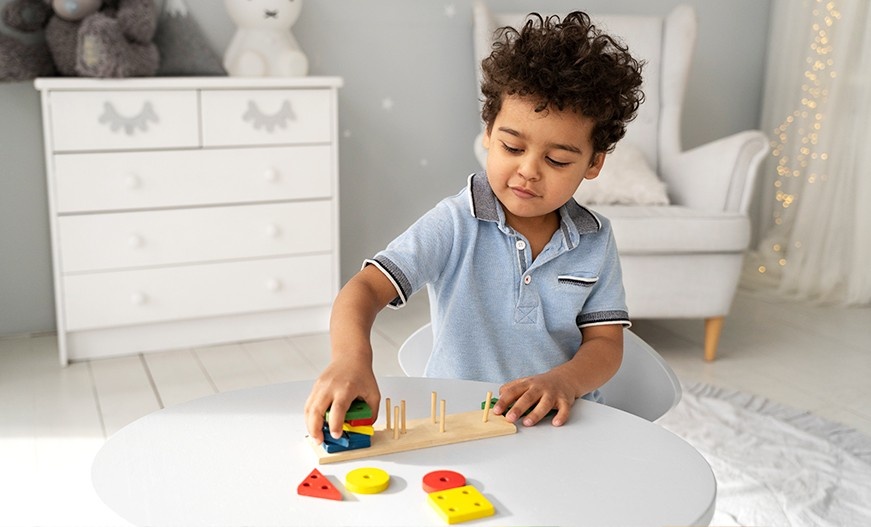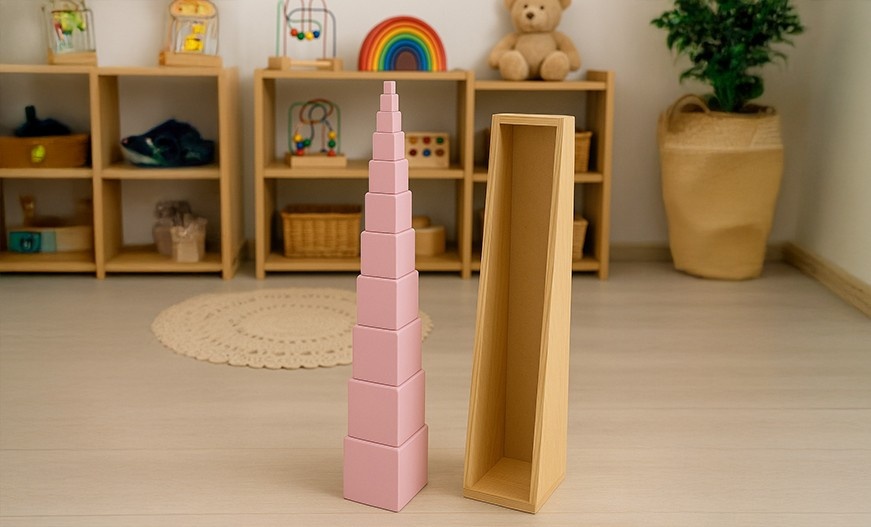Currently Empty: ₹0.00
What Is Montessori? Meaning, Method, & Montessori Material

Written By: Pinky Kharata
Published By: Satya Narayan Pandey
Montessori education is a gentle and caring way to support how children learn and grow. Developed by Maria Montessori, the approach allows children to learn at their own pace by engaging in real-life tasks. It is not about remembering or hurrying. Instead, children learn by doing and using special Montessori materials like the Pink Tower Montessori or Red Rods Montessori.
These aids make the learning process enjoyable, practical and purposeful. The Montessori system assists in developing confidence, independence and the actual love of learning. It allows kids to have the independence of choice, concentration and exploration in a relaxed and joyful environment.
What Is Montessori Education?
Montessori education is a learning method, which is based on the natural curiosity of a child rather than rigid lessons. In the Montessori classroom, kids learn through Montessori materials and real life activities. It focuses on building confidence and independence, without using grades or tests. The Montessori system looks at all children as potential learners and ready to learn once provided with the appropriate environment.
Key Characteristics of Montessori Education
Following are the key characteristics of Montessori education that make it effective. These fundamental aspects are drawn upon the method by Maria Montessori and allow every child to follow his or her innate curiosity, independence, and overall development in a mindful, hands-on learning atmosphere.

1. Prepared Environment
The most important thing in Montessori education is a peaceful and ordered environment. All is put at the child level and is organized in a way that it invites learning. This is a place where concentration, selection and accountability are promoted, where children feel competent and able when working with Montessori materials at their own time.
2. Mixed-Age Group
A Montessori classroom contains children of varying ages learning together. The younger kids get to learn through observing the older kids and the older kids get to develop leadership and confidence through assisting others. This Montessori system brings about a great community feeling, cooperation and respect among the learners.
3. Freedom
The Montessori education system allows the child to have freedom of choice of activities but within limits. This liberty develops independence, choice making and learning to love learning. They own their work with guidance and they become focused, disciplined and confident in the long run.
4. Montessori Apparatus
Pink Tower Montessori and Red Rods Montessori are such tools that provide actual, sensorial learning. These aren’t just toys, they’re meaningful Montessori materials designed to build focus, logic, and sensory awareness. The children are engaged in learning by doing rather than memorizing with the use of exquisitely designed objects with a definite purpose.
5. Trained Montessori Teachers
The teachers who follow the Montessori method do not lecture, unlike traditional teachers. They are professionally prepared to watch, understand and tend to the needs of every child. They assist children in learning, and not pushing them with great respect to the philosophy of Maria Montessori.
6. Unintrupped Work Periods
Long periods of time are allowed during which children are expected to focus on uninterrupted activity. This liberation of concentration develops concentration, self-confidence and self-reliance. It permits the process of learning to proceed in its natural manner without the ding-dong or rigid lessons to disrupt the process.
7. Respect for the Child
One of the core Montessori meanings is treating each child with deep respect. Choices matter. One hears voices. Children are not provided with set instructions that they should adhere to; rather they are promoted to express their thoughts, find solutions to problems, and be able to think in any way they like.
8. Independence
What is the true magic of Montessori? It consists in cultivating autonomy. The children are given the autonomy to choose their work, to move around and to decide. This will foster self confidence, responsibility and self drive at a very tender age.
The Montessori Method Explained
Children excel when they are made to believe in learning at their own time. That is the essence of the Montessori system, invented by Maria Montessori. It revolves around self-directed learning, real life tasks and a relaxed, ordered environment, allowing children to gain confidence, independence and a life-long love of learning, by exploring the ordinary.

Core Principles Montessori Method
The Montessori system allows children to indulge in activities of their interest and challenge. This develops concentration, inquisitiveness and self drive. A Montessori environment is quiet and orderly, and allows individual and group work. The Montessori materials help develop personal thought and learning through enjoyment.
How Does It Differ from Traditional Education?
The Montessori method is very different to traditional education because it takes into account the natural learning rhythm of the child and his/her interests. This is how Montessori education provides a special, practical approach through Montessori materials and supports the whole person’s development.

1. Focus on Experimental Learning
The Montessori education opposed to the traditional one encourages children to learn through doing. Children learn by engaging in experiences that help them think, develop motor skills, and creativity. This participatory approach develops a deeper knowledge and teaches them to apply their learning to their lives which is central to the Montessori system.
2. Real-Life Tools and Materials
Montessori materials like the Pink Tower Montessori or Red Rods Montessori help children learn through touch, sight, and movement. These are well planned tools that will teach math, language and others in a practical manner. This brings learning to reality and significance as opposed to textbooks in the traditional learning.
3. Social, Emotional, and Intellectual Development
Montessori education does not only support academics but the entire child. Through collaboration, problem-solving, and relearning at their pace, children develop emotionally, socially and even mentally. The respectful, peaceful Montessori classroom facilitates independence, empathy, and a sense of self.
Who Was Maria Montessori?
Maria Montessori was an Italian physician and educator that developed the well-known Montessori system of education. She was initially an engineering student and eventually among the earliest female doctors in Italy. It is through this philosophy that her learning process, through the use of real life experiences and independence, is still applied in Montessori learning institutions all over the world today.
Iconic Montessori Materials
Montessori education involves hands-on learning tools. These are well-planned toys that assist children in developing practical skills through playing. Whether through size sorting, sensory discovery, or otherwise, these Montessori materials ignite a sense of curiosity, independence, and joy of learning, making them just as effective in the home as they are in the classroom.
1. The Pink Tower Montessori Tool

The Pink Tower Montessori toy develops early mathematics and logic. Using 10 solid wood blocks of various sizes, children aged 3 and up discover size, order and balance. This Montessori material helps to develop fine motor skills, spatial sense, and early math along with problem-solving skills all by stacking, arranging, and playing.
2. Red Rods Montessori Tool

Red Rods Montessori tool helps kids aged 3+ explore length and order. They develop logic, attention, and early mathematics concepts as they line up 10 wooden rods in order of length. It is a sensorial Montessori material as well that enhances coordination, patterning and thinking independently whilst playing on a daily basis.
3. Busy Board

The Busy Board is a 10 in 1 Montessori inspired toy, which aids the development of fine motor and thinking skills in toddlers. It has zips, laces, puzzles, and sliders, which stimulate independent play, development of logic, and hand-eye coordination. It is constructed with safe wood, and it is an excellent addition both at home and classroom learning.
4. Montessori Brown Stairs

Montessori Brown Stairs tool consists of 10 solid wood blocks, suitable for children aged 3 and more. It promotes problem solving, early numeracy and sensory play. Children will stack and compare sizes, building logic and coordination. It is constructed of sturdy wood and is simple to maintain, it can be used during guided learning or independent learning.
5. Montessori Knobbed Cylinders

The Montessori Knobbed Cylinders set consists of 25 wooden cylinders of different colors on a firm stand, suitable for children aged 3 years and above. It assists with early numeracy, develops vocabulary and improves co-ordination. Vivid colors and active play help children to be involved as they sort, match and compare, it stimulates independent play and discovery through touching.
Why Montessori Still Matters Today?
Montessori method remains significant even nowadays as it enables children to be independent, curious and confident learners. Montessori education uses practicable tools such as the Pink Tower Montessori to develop actual comprehension instead of mere remembrance of facts. It promotes feelings, social and cognitive abilities, thus a good option in contemporary learning.
Takeaway
Child-directed learning promotes curiosity, self-assurance, and life-long skills in any child. Based on the idea of Maria Montessori, this system believes in freedom, responsibility, and discovery learning. With thoughtfully designed toys and tools like Red Rods Montessori, Busy Boards, Brown Stairs, and Cylinder Blocks, children grow emotionally, socially, and intellectually, making it a trusted and enriching choice for today’s parents, teachers, and learners.
FAQs: Montessori Material & Learning
Have some questions about Montessori? You are at the right place. This easy to follow guide addresses the most frequent questions about Montessori education, Montessori material, and the Montessori method. Whether you’re new or just curious about what Montessori is, these quick FAQs cover all the basics.
Q1. What is the main purpose of Montessori?
Ans: The primary goal of the Montessori system is to assist children in becoming independent, curious, and confident learners. It follows the Montessori method created by Maria Montessori, using hands-on tools like the Pink Tower Montessori and Red Rods Montessori.
Q2. What is not allowed in Montessori?
Ans: Montessori classroom does not permit forced learning, grades or punishment. Rather it is freedom within bounds. Competition is also shunned traditionally in favour of natural development through Montessori materials.
Q3. What age does Montessori start?
Ans: Typically Montessori education begins at 2.5 -3 years of age. Children are ready to learn at this age to sort objects or use Pink Tower Montessori to learn about space.
Q4. What is the biggest criticism of Montessori?
Ans: A significant fault found with Montessori is the unstructured nature and low emphasis on testing or grades. Others believe that it might not allow children to be ready about conventional schooling systems. Nevertheless, the adherents of the Montessori method appreciate the emphasis put on genuine comprehension.







